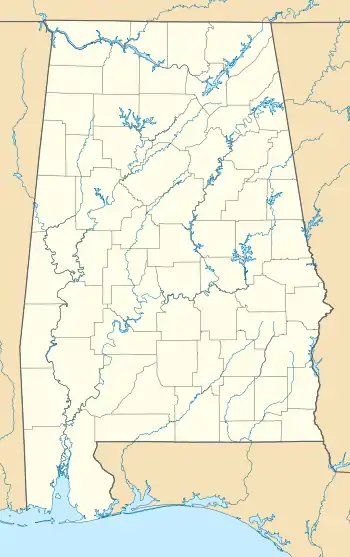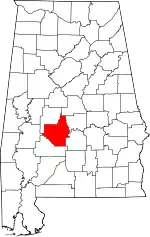Pleasant Hill, Alabama
Pleasant Hill is an unincorporated community in Dallas County, Alabama.[2]
Pleasant Hill, Alabama | |
|---|---|
 Pleasant Hill Alabama Volunteer Fire Department | |
 Pleasant Hill Location in Alabama  Pleasant Hill Pleasant Hill (the United States) | |
| Coordinates: 32°09′56″N 86°54′43″W | |
| Country | United States |
| State | Alabama |
| County | Dallas |
| Elevation | 404 ft (123 m) |
| Time zone | UTC-6 (Central (CST)) |
| • Summer (DST) | UTC-5 (CDT) |
| ZIP code | 36775 |
| Area code(s) | 251 |
| GNIS feature ID | 155207[1] |
History
The community began as a trading post called Fort Rascal prior to the Indian removal. It gained a post office in 1828 and the name was changed to Pleasant Hill.[3] The community was visited by Philip Henry Gosse, an English naturalist, for an eight-month period in 1838 when he taught school for Reuben Saffold, a local planter and justice of the Supreme Court of Alabama. His studies and drawings of the flora and fauna of the area and his recollections of slavery were later published in his book Letters from Alabama.[4] Pleasant Hill has one site included on the National Register of Historic Places, the Pleasant Hill Presbyterian Church.[5] It has several sites listed on the Alabama Register of Landmarks and Heritage and one nearby, Belvoir.[6]
Demographics
| Historical population | |||
|---|---|---|---|
| Census | Pop. | %± | |
| 1880 | 193 | — | |
| U.S. Decennial Census[7] | |||
Pleasant Hill was listed on the 1880 U.S. Census as having a population of 193.
Notable people
- Sidney Johnston Catts, 22nd Governor of Florida
- Johnnie Cowan, infielder in Negro league baseball
References
- "Pleasant Hill". Geographic Names Information System. United States Geological Survey.
- "Pleasant Hill, Alabama". "AL HomeTownLocator". Retrieved 2008-11-05.
- Sims, Michael Vaughn. "Pleasant Hill Presbyterian Church: An endangered historic property in Pleasant Hill, Alabama". Archived from the original on 2009-10-26. Retrieved 2008-11-05.
- Gosse, Philip Henry (1993) [1859]. Letters from Alabama, (U.S.) chiefly relating to natural history (Annotated ed.). Tuscaloosa: University of Alabama Press. pp. 7–21. ISBN 0-585-32308-9.
- "National Register Information System". National Register of Historic Places. National Park Service. July 9, 2010.
- "Properties on the Alabama Register of Landmarks & Heritage". Alabama Historical Commission. www.preserveala.org. 4 June 2009. Retrieved 28 November 2010.
- "U.S. Decennial Census". Census.gov. Retrieved June 6, 2013.
